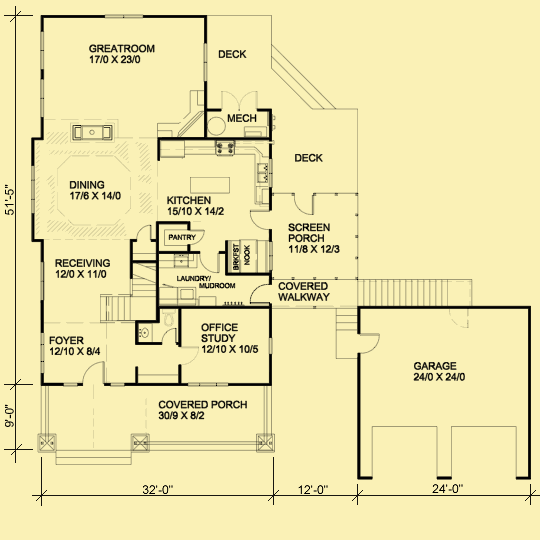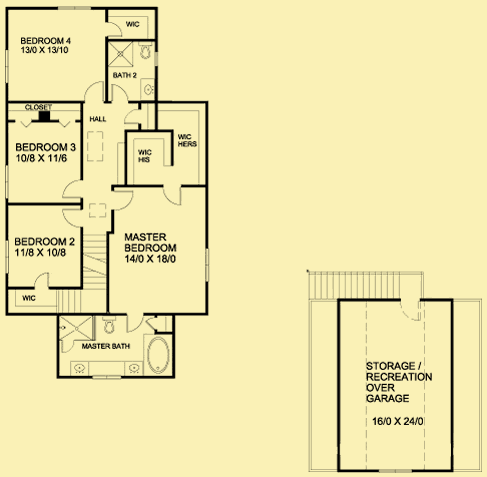Main Level Floor Plans For Simple Solar Craftsman

Upper Level Floor Plans For Simple Solar Craftsman


| Total Above-ground living area | 2736 |
| Main Level | 1511 |
| Upper Level | 1225 |
| Lower level living area | |
| Footprint The dimensions shown are for the house only (indicating the smallest area needed to build). They do not include the garage, porches, or decks, unless they are an integral part of the design. |
32 W x 51.417 D |
| Above-ground bedrooms | 4 |
| Above-ground bathrooms | 2.5 |
| Master suite | Upper |
| Lower-level bedrooms | 0 |
| Lower-level bathrooms | 0 |
| Stories | 2 |
| Parking | garage |
| Number of stalls | 2 |
| House height
Traditionally, the overall height of a house is determined by measuring from the top of the finished floor on the main level, to the highest peak of the roof.
|
26 |
| Ceiling heights Raising or lowering the height of the ceilings on one or more floors of a house is often a simple change that can be made by your builder. However, if you want to raise the ceiling of the main floor of a two-story home, there has to be room to add steps to the existing staircase. |
|
| Main level | 9 |
| Upper level | 8 |
| Vaulted ceilings
We consider a room to be vaulted if the ceiling - whether flat, angled, or curved - is above 10 feet at its highest point. If you prefer that one or more rooms not be vaulted in your new home, this is a very simple change that your builder can make for you.
KEY TO SYMBOLS: LR = Living Room/Great Room DR = Dining Room FAM = Family Room FOY = Foyer STU = Study/Library/Den KIT = Kitchen SUN = Sunroom MBR = Master Bedroom MB = Master Bath LOF = Loft OFF = Office/Guest Room REC = Recreation/Game Room ALL = Entire Level |
|


Like all of Mr. Hartford’s designs, this house was originally designed as an energy–efficient, passive solar home. You can of course build this house facing in whatever direction suits your needs, but if you’re interested in building it as a passive solar home, please read the section below titled Passive Solar Info for specific information on orientation.
The 8’–deep covered front porch spans the entire front of the house. As you step into the foyer, there’s a short hallway on your right that accesses both a powder room and a sunny office/study with views to the front and side. Just across from the powder room there’s a custom built phone and mail station with a drop–down writing table. Straight ahead from the foyer is a receiving area with an open Craftsman–style staircase jutting into it. Both the foyer and the receiving areas feature large windows for sunlight and views.
Just ahead is the dining room, which is distinguished by an octagonal coffered ceiling. This room features a large double–sided fireplace, a bumped–out wall with a trio of windows, and (like the rest of the rooms on this level) a lofty 9′ ceiling. Openings on either side of the free–standing fireplace lead to the great room at the rear of the house. This room enjoys views in three directions, and the original homeowners requested a built–in media center in the corner.
Next to the dining room, and open to it, is the kitchen. It features a center island, a pair of windows over the sinks for light and views, a walk–in pantry, and a lovely Craftsman–style built–in breakfast nook. One door in the kitchen opens to a screened porch that would be ideal for outdoor dining in warmer months, and another opens to a laundry/mudroom. A door in the screened porch opens to a large deck area, while a door in the laundry area opens to a breezeway leading to a 2–car garage. An exterior stairway covered by a long roof overhang on the back of the garage leads up to a private studio / bonus space. This area might also become an efficiency apartment in the future.
All four bedrooms are located on the upper level. The master bedroom has a door at one end that opens to a pair of extra large walk–in closets, and a door at the other end that opens to the master bath. This room has both a soaking tub and a large shower, and two separated vanity areas. There are two small side–by–side bedrooms that could be converted to one large bedroom by omitting the wall between them, and a larger bedroom at the rear of the house.
Passive Solar Info
To maximize its passive solar design, the front of this house should face East (or West, if the house is reversed).




This simple Craftsman–style home is only 32' wide, making it ideal for narrow lots in either an urban or rural setting. Attractive shed dormers on each side create enough space for 4 bedrooms on the upper level, allowing for more living space on the main level.
We highly recommend that you click on two boxes – the number of bedrooms you know you need, and one less bedroom. For example, if you need 4 bedrooms, click on the boxes next to 4 and next to 3. Otherwise you will not see homes where existing rooms on the lower, main, or upper levels might work perfectly well as a bedroom instead of as an office, study, etc.
